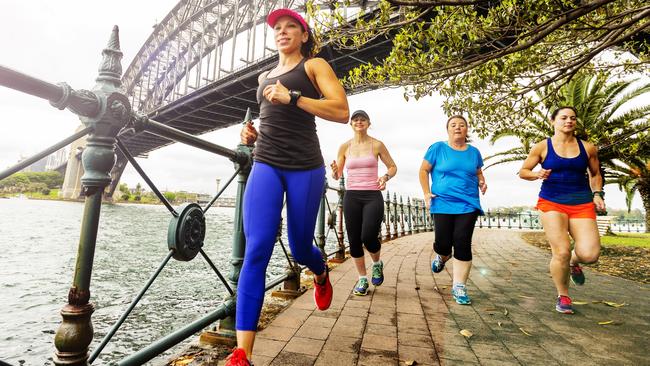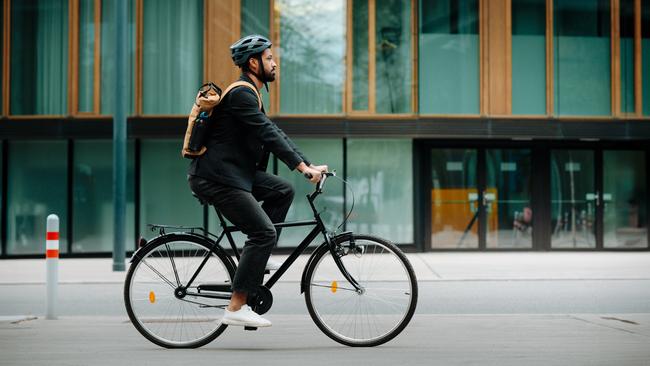Why you should always take the stairs to live longer
Exercise will do many things, but will it really help you to live longer? The experts tell Peta Bee how.

Exercise will do many things, but will it really help you to live longer? Research by Lennert Veerman, professor of public health at Griffith University’s school of medicine and dentistry in Australia, shows that exercise is akin to a longevity jab and that by increasing physical activity, we can add as much as 11 years to our lifespan.
Veerman says that even midlifers who are at present less active than average could add six hours of life expectancy for each one-hour daily walk. If you are over 40 and your tracker tells you that you move about for less than 50 minutes a day, you could extend your life by five years by spending more time on your feet.
The statistics come from Veerman’s latest study, published in the British Journal of Sports Medicine. Using data obtained from hip-worn fitness trackers on more than 35,000 people, Veerman and his colleagues found the effects of exercise on longevity were about twice as strong as had been previously estimated.
Those in the top quarter for activity levels amassed 160 minutes of daily movement and were found to be at a 73 per cent lower risk of premature death than their least active counterparts who managed an average 49 minutes of activity each day. “It can be any type of exercise but the biggest benefits come with roughly the equivalent of just under three hours of walking per day,” he says.
Guidelines set by UK medical chiefs suggest we should aim for a minimum of 150 minutes of moderate-intensity activity or 75 minutes of vigorous-intensity activity a week, spread evenly over four to five days a week, or every day, plus some additional strengthening exercises on two days a week just to stay healthy.
It’s not for the first time that researchers have suggested that exercising more than the recommended minimum could lengthen life. Harvard scientists looked at three decades’ worth of medical records and mortality data for more than 100,000 adults for a study in Circulation journal, and suggested that doubling or even quadrupling minimum activity guidelines slashed the risk of dying prematurely from cardiovascular and other diseases by almost one third.
“Physical activity, not just hard exercise, lowers blood pressure, which reduces risks of heart disease and stroke and other cardiovascular disease,” Veerman says. “It can reduce stress levels, which may improve immune responses, and it improves mood, which may prevent suicide and coping with the use of alcohol and other drugs, which have knock-on effects on health behaviours.”

He also says we don’t need to hit the gym, run marathons or even do a weekly 5km Parkrun. All types of activity, including the incidental movement we clock up throughout the day, has been “vastly underestimated”, Veerman says, yet it is “enormously powerful” in its capacity to improve health outcomes.
“Our figures are based on time spent doing ‘walking equivalents’ so it could be any movement – whatever made the hip-worn accelerometer or tracker tick, if you will,” he explains. “That’s not limited to what we think of as ‘exercise’ – activity done for health reasons – but walking to the bus stop, pottering around the house.”
Being more active is the simplest step to more than halving your risk of early death. At 53, Veerman says he views exercise as a means to prolonging his “healthspan” – the number of years lived healthily – and crams in as much of it as he can. “I’m at the higher end of the activity spectrum and I start my day with 30 push-ups,” he says. “I have a dog to walk, and he likes long walks, so that’s at least half an hour twice a day and on most week days, I will cycle 4km to work and back.” He also goes to the gym, occasionally swims and does a weekly Parkrun. But he concedes a fitness lifestyle isn’t for everyone.
“My main message is that any activity will make a massive difference, and the first steps give you the most benefit,” Veerman says.
Here are the simplest ways to exercise your way to a longer life:
How little can you get away with?
Depending on your starting point, the more activity you add, the better the outcome. “Over-40s and people with underlying risk factors from disease who are currently not very active will benefit the most from adding even small amounts to their daily activity total,” Veerman says. “Find something you like, with people you like and it’s your thing. Use your watch or set a target for steps, but cut yourself some slack on days when nothing works.”
Activity of surprisingly short duration will make a difference. In a Nature Medicine study involving more than 25,000 UK non-exercisers, Emmanuel Stamatakis, professor of physical activity, lifestyle and population health at the University of Sydney, showed that performing bouts of vigorous activity lasting 60-120 seconds and performed 3-4 times a day led to about a 40 per cent reduced risk of premature death from any cause, and about a one third lower risk of dying early from cardiovascular disease compared with people who didn’t do the same sort of activity.
This doesn’t need to be a high-intensity interval training, but what Stamatakis terms Vilpa, or “vigorous intermittent lifestyle physical activity”, such as running a short distance for a bus, powering up and down stairs or speed walking two to three times for 20-30 seconds on a ten-minute stroll.
“Doing 60-120 seconds bursts of Vilpa for a total of 4.4 minutes a day had a dramatic effect on health outcomes,” Stamatakis says.
Always take the stairs

One of Veerman’s activity rules is “to take the stairs every time” and to walk up them with effort. Marching up and down more than five flights of stairs a day was associated with improved blood sugar and cholesterol levels as well as with lowering blood pressure and other risk factors for heart disease, in a 2023 paper published in Atherosclerosis journal.
This year, Dr Sophie Paddock, a researcher at the University of East Anglia and Norfolk and Norwich University Hospital Foundation Trust, told the European Society of Cardiology conference that frequent stair climbing is associated with a longer life. Her review of nine studies, involving nearly half a million participants, showed that stair climbing is linked with a reduced risk of cardiovascular disease, including heart attack, heart failure and stroke, and a 24 per cent reduced risk of dying early from any cause.
Is there a tipping point for longevity benefits from exercise?
This year, a study of more than 40,000 British women and 30,000 British men in their sixties by Tom Yates, professor of physical activity, sedentary behaviour and health at the University of Leicester, suggested that if you start at zero on the activity scale, extra years of life can be gained by increasing the overall amount of physical activity done (walking or cycling for longer), or the intensity of exercise (moving faster), but that the greatest gains came from doing both over time. When it comes to life extension, there’s a tipping point though, and Veerman showed that the benefits of the activity tailed off at the equivalent of just under three hours’ walking or incidental movement a day.
“If you’re already very active or in that top quartile doing 160-180 minutes of activity, an extra hour’s walk may not make much difference as you’ve, in a sense, already ‘maxed out’ your longevity benefit,” Veerman says. “Based on the evidence we have, those in the top 25 per cent for daily activity levels would probably not gain further benefit by doing more.”
Build up gradually
Including some vigorous activity in your exercise routine has been shown in large studies, including one in the BMJ, to provide greater protection against premature death than moderate activity alone.
However, diving into strenuous exercise straight from a sedentary lifestyle comes with risks. “While activity strengthens the heart muscle, if your coronary arteries are only just letting through enough blood to keep things going under low activity levels, oxygenation of the heart may be insufficient at higher activity levels, which may trigger arrhythmia, which could be dangerous,” Veerman says. “So start easy and build up. Walk before you run and then add short bursts of higher effort.”
If you do want to start something that’s a bit more intense, consult your doctor first, and if you feel any pressure on your chest, stop and seek medical attention.
Walk briskly for at least ten minutes a day
Inactive over-60s who add a ten-minute brisk walk to their daily routine – that’s a pace of at least 100 steps a minute – can experience a noticeable increase in life expectancy. Professor Yates has studied the effects of walking on longevity for decades and his most recent study in the Journal of Sport and Health Science showed that just ten minutes of brisk walking a day led to an average of 0.9 extra years lived for women and 1.4 years for men. Increase that to 30 minutes daily and the results are even more impressive. “From our large study, we found that adding a daily 30-minute brisk walk was linked to an extra 1.4 years lived in women and 2.5 years lived in men,” Yates says.
Get on your bike

Research published in JAMA Internal Medicine showed that people with type 2 diabetes who cycled for one hour a week were at a 22 per cent reduced risk of dying prematurely. Immune cell biologists at Birmingham University’s Institute for Inflammation and Ageing showed that lifelong cycling slows down the ageing process, with dedicated cyclists in their fifties to seventies having more youthful immune systems than sedentary people.
Meanwhile, Professor Alister Hart, consultant orthopaedic hip surgeon at the Royal National Orthopaedic Hospital, showed in another study that enthusiastic middle-aged cyclists had healthier and more youthful muscles. According to Hart, regular pedalling throughout middle age not only made muscles in the legs and glutes stronger but resulted in significantly lower levels of fat settling between the muscle fibres compared with the sedentary participants.
“Cycling is a great way to stay healthy for much longer,” Hart says.
The Times




To join the conversation, please log in. Don't have an account? Register
Join the conversation, you are commenting as Logout